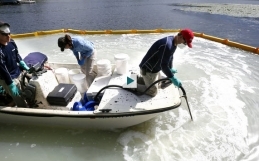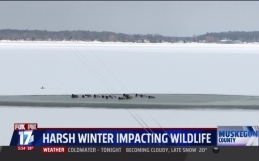What does HR 872 mean for the environment and human health?
- Regulation of Pesticides – Registration and labeling of pesticides under FIFRA already requires that EPA ensure that the use of a pesticide result in ‘no unreasonable adverse effect’ to humans or the environment. Pesticides and pesticide residues are reviewed for their impacts on water quality, and labels are crafted to minimize impacts.
- It’s a Permit to Discharge! – The activist talking points are flat wrong – permits granted under the Clean Water Act do NOT prevent pollutants from being discharged into our waterways! As a matter of fact the National Pollutant Discharge Elimination Permit (NPDES) is in fact a permit to discharge! In the case of pesticides, it’s a permit to discharge a substance that is already evaluated by EPA for impacts to water quality…no other permitted discharge is double regulated by EPA in this manner!
- The Fish Myth – Fish kills have occurred from the misapplication of pesticides, and, in those circumstances, current laws have been violated. Pesticides designed for direct and near water application are specifically assessed and labeled by EPA to ensure that aquatic ecosystems are protected and ensure only the targeted ‘pests’ are impacted. This bill does not change existing law as it relates to misapplication of pesticides, either under FIFRA or the Clean Water Act. As a matter of fact, maintaining that legal line is specifically included in the bill – if you violate a pesticide label in manner that adversely affects water quality you could be in violation of one or both laws. Filling out paperwork and paying a fee to get a permit does NOT prevent fish kills: following the pesticide label does!
- Human Health Protections – The National Center for Diseases officially recognizes the following as a partial list of mosquito-borne diseases – Eastern Equine Encephalitis, Japanese Encephalitis, La Crosse Encephalitis, St. Louis Encephalitis, West Nile Virus, Western Equine Encephalitis, Dengue Fever, Malaria, Rift Valley Fever and Yellow Fever. Inadequate control of these pests threatens public health.
- Forest Health & Invasive Species Protections – EPA’s permit scheme will result in a reduction in the use of forest pest control as a forest management tool, resulting in the acceleration of tree mortality and general decline in overall forest health. The permit will also create barriers to the control of pests, such as Gypsy Moth and Forest Tent Caterpillar. This may result in a higher incidence of preventable tree kills and defoliated landscapes.
What about that USGS Study touted by those opposing HR 872?
Many references are made to the USGS report “The Quality of Our Nation’s Waters – Pesticides in the Nation’s Streams and Ground Water, 1992-2001.” Here is what the activists are not telling you about the USGS data…
- Detections don’t mean there’s a problem! For instance, ‘At least one pesticide was detected generally below levels of concern in waters from all streams studies, and pesticide compounds were detected throughout most of the year in water from streams with agricultural…land-use watersheds.’ This kind of information may sound scary but, in reality, it is an expected result because “USGS analytical methods were designed to measure concentrations as low as economically and technically feasible. By this approach…pesticides were commonly detected at concentrations far below Federal or State standards and guidelines for protecting water quality. Detections of pesticides do not necessarily indicate that there are appreciable risks to human health, aquatic life, or wildlife.” (p. 33).
- Not a widespread problem! – Most of the 75 products actually studied were found at either non-detection levels (ND) or detected very infrequently.
- Looks can be deceiving! – The 2006 report’s map of NAWQA agricultural watershed sampling sites (p. 37) suggests that the 83 agricultural watersheds and basins selected may have had the additional selection criterion of providing the greatest likelihood of pesticide detections, which could have had the effect of biasing the total percentage of “agricultural detections” in the study. Monitoring sites selected were often closely bunched within discrete regions of targeted states while many other agricultural regions and states were either completely or largely ignored. The data is snapshot but does not tell the whole story!
- It’s old news. – The NAWQA study was initiated almost 20 years ago, and many of the product detections declined throughout the study because of forces such as changes in agricultural management practices, advances in science, market forces, and regulations.
- There is good news! – What you won’t hear from the activists is that more recent data in the 2009 USGS report, “Pesticide Levels Decline in Corn Belt Rivers,” referenced lower detections from 1996 to 2006 (http://pubs.usgs.gov/sir/2009/5132/). The more recent report concluded that, overall, use is the most dominant factor driving changes in detected concentrations in sampled water. Referencing the House hearing statement of Dr. Sullivan, lead author of the 2009 report, in which the reported concentration downtrends for several important Corn Belt pesticides from 1996 to 2006 ‘indicat[e] the possibility that agricultural management practices may have increasingly reduced transport to streams…” That means better labels, and better practices under pesticide laws are better protecting waters with out any permit under water laws!
What does HR 872 mean to pesticides users?
- So many affected! – EPA’s own analysis suggests that the NPDES permits program for pesticides will result the single greatest expansion of the program in its history, covering approximately 5.6 million covered pesticides applications per year by 365,000 applicators. Those affected include state agencies, city and county municipalities, mosquito control districts, water districts, pesticide applicators, farmers, ranchers, forest managers, scientists and many others.
- The permit cover applications of pesticides registered for aquatic use and applied to water or forest canopies into or over flowing or seasonal waters, and conveyances to those waters.
- EPA does not intend for the permit to cover pesticide applications registered and intended for terrestrial use.
- Remember how we got here! It was the numerous activist lawsuits against both agricultural and non-ag users of aquatic and terrestrial pesticides that led us asking Congress to clarify the intention of Clean Water Act. Despite the activist’s lack of urgency, the very same groups who oppose HR 872 make no secret of their intention to continue their citizen suits until all pesticide applications are permitted if even a chance that the pesticide could come in contact with any “water,” either flowing water or seasonal drainage ditches that could be a conveyance to a water of the US.
- So much uncertainty. Nothing in the CWA or the permit protects against citizen suits against farmers or terrestrial applicators for not obtaining a permit. After all, it was citizen lawsuits that prompted EPA to put out the 2006 rule the court overturned – lawsuits were filed against both agriculture users and non-agricultural users. Real world liability for remains for farmers and ranchers, as well as users applying pesticides to golf courses and public utility rights of way, and private homes and businesses.
What does HR 872 mean for states?
- $$$$$ and Time! States are and will continue to spend millions of dollars and dedicate thousands of man-hours writing, implementing and enforcing a permit that most regulators believe does little if anything to further protect water quality.
- ‘Why are we doing this?’ Paraphrasing a state regulators comments during a recent House hearing, ‘When regulators are looking at how to develop this permit, they look at what the [general] permit will do protect water quality in addition to what the FIFRA label already requires. In this case, the permit doesn’t add any protection: registration and labeling of the pesticides already does as much as the general permit would require. So, now regulators and users are left with a paperwork exercise.’
- Existing state permits are NOT affected. The bill will not affect state regulatory programs created under state authority, or programs created based on states’ authority to make regulations more stringent than required under federal law. Existing state permits established under these authorities are not affected by the bill.
What does HR 872 mean for EPA?
- Pesticides are already regulated. EPA has repeatedly said that the current pesticide permitting process under FIFRA provides sufficient environmental protection for pesticide applications over water. “EPA uses its full regulatory authority under FIFRA to ensure that pesticides do not cause unreasonable adverse effects on human health or the environment, including our nation’s water resources,” said Steven Bradbury, director of EPA’s Office of Pesticide Programs, at a hearing last month (E&E Daily, Feb. 17).
- Status Quo. Legally, HR 872 maintains the status quo – it merely returns the EPA’s enforcement authority back to where the agency believed the law to be prior to the National Cotton Council ruling by the 6th Circuit. Remember, it was EPA’s 2006 rule exempting pesticide applications from the Clean Water Act that led us to the misguided ruling from the 6th Circuit.
- Drafted the bill. EPA provided technical assistance in the drafting of the legislation to ensure that the bill corrects the error of the court – no more, no less.
What does the court extending the deadline extension of the final permit mean?
- No Change in Burden and Duplication – This brief delay only puts us exactly where we were before but with more breathing to correct the court’s error — a duplicative program is still about to take effect while states and users continue to devote limited resources to develop a program and prepare for permits that may eventually be rendered null by Congress. For EPA, state regulators, and user permittees the extension does not change the fact that the permit is legally duplicative and bureaucratically unneeded. Final negotiations are far from over and many states are not releasing final permits until EPA releases a real, final permit later this year… October will be here before we know it!
Contact your Elected Officials – PASS THIS BILL!!!
Related Posts


